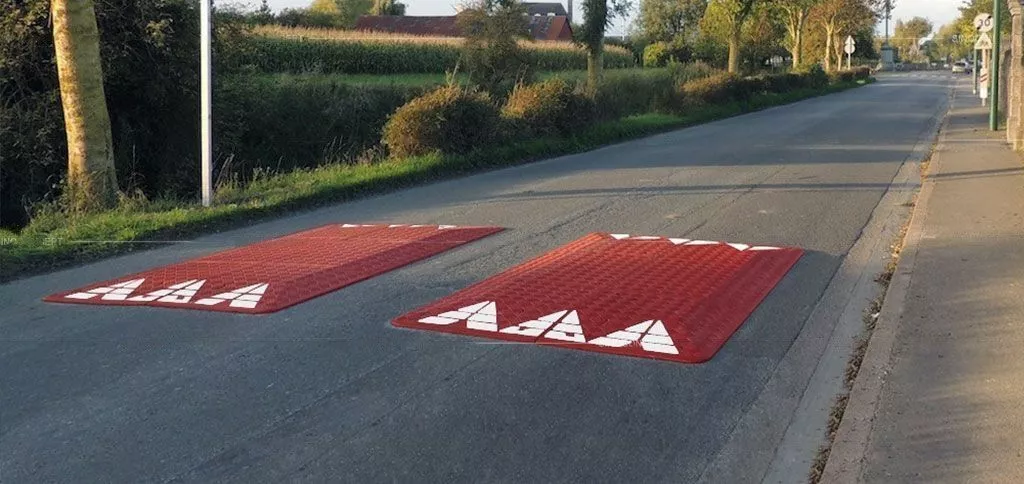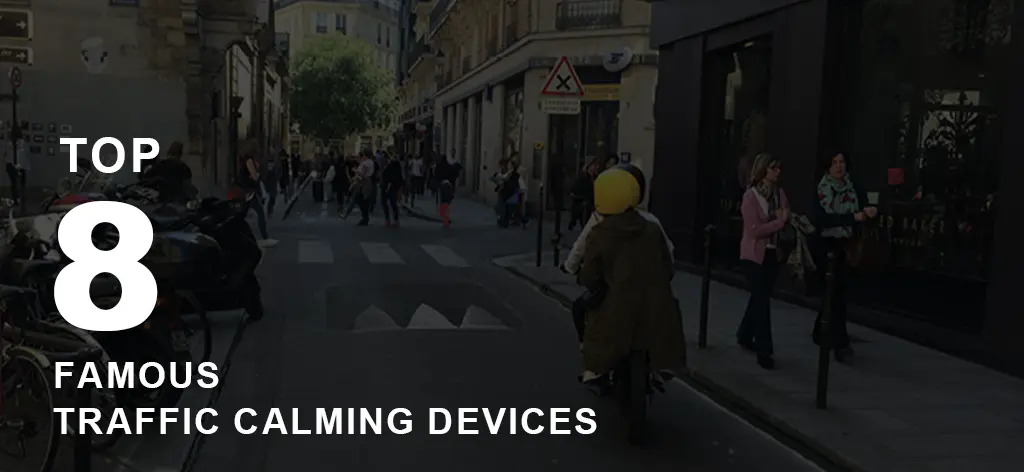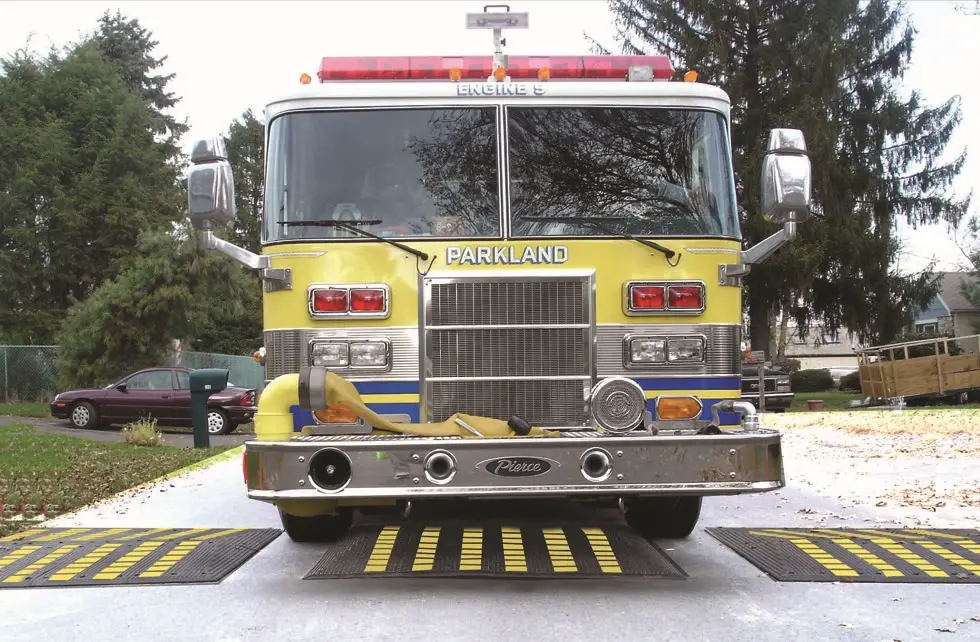What are the Most Famous Traffic Calming Devices?
Exceeding the speed limit on roads and city streets can be disastrous. It can damage costly properties and cause the loss of precious lives. That is why slowing down speeding vehicles is one of the best ways of saving thousands of lives we lose every year and preventing injuries or reducing their extent.
But what can be done to make motorists reduce their speeds and drive within the safe speed limit?
The answer is traffic calming measures! These devices, signs, or signals help the transportation department and federal highway administration accomplish this goal.
This article will teach you about the most famous traffic control devices and their key advantages.

Discover here our full range of Speed Cushions!
What are traffic calming devices?
According to transportation engineers, traffic calming devices are physical road signs, pavement markings, and tools that slow down motorists, cyclists, bicyclists, and all other vehicles to make city streets, parking lots, and roadways safe for all.
They change drivers’ behavior by making them more aware of their surroundings and speed limits, helping make outdoor areas safe for non-motorized road or street users. Traffic data shows that traffic management and pedestrian safety devices have greatly reduced road accidents.
Some examples of traffic calming measures that we often see around us are:
- Traffic signal
- Speed cushion
- Speed hump / Road bump / Speed ramp / Speed breaker
- Speed limit sign
- Speed table
- Pedestrian signal
- Street lighting
- Guide signs
- Rumble strips
- Bollards
- Advance warning signs
- Stop lights
- Road markings
- Traffic cones
These devices are combined to control traffic speed, volume, and flow in a school zone, slow zone, or pedestrian zone.

Why are traffic calming devices important?
There is no doubt that slowing down vehicles is very effective in making roads safe for pedestrians and drivers. It can prevent road accidents, and even if an accident occurs, it can greatly reduce its severity.
Each 1-mph (miles per hour) reduction in the speed of a vehicle reduces its chances of collision with another car or pedestrian by 5%.
If a vehicle is moving at 40 mph speed, sees a pedestrian around 100 feet away, and tries to reduce its speed, it will still collide with him/her at 38 mph speed. In contrast, if the speed of a vehicle has been reduced to 20 to 25 mph by a traffic calming device, it will be much easier for the driver to stop before the collision and prevent the accident.
A research study shows that the chances of fatal injuries are only 3.5% if a vehicle moves at 15 mph speed. The injury risk increases to 83% at 44 mph.
All these points show how important controlling vehicular speed is. It can help you manage traffic volume, enhance traffic safety multiple times, make roads safe for foot traffic, and promote a conscious driving style.
All the calming traffic tools are devised to slow down vehicles and make roads or city streets safe to walk or drive on.
Get in touch
The Speed Cushions Factory is a leading manufacturer of rubber speed cushions located in Qingdao, China.
Feel free to contact us!
We are always here to help!
Qingdao, Shandong Province, China.
sales@speed-cushion.com
How can traffic calming devices improve traffic conditions?
Traffic calming devices make it easier for people to follow traffic rules and discourage accidents or fatalities. They improve traffic conditions in the following ways.
They inform drivers of speed limits in a certain area, like a work zone or slow traffic zone, and force them to reduce acceleration. Slowing down drivers can prevent crashes between vehicles.
They improve traffic and driving conditions for non-motorized transportation. Pedestrians, cyclists, and bicyclists feel more confident and comfortable using roads, parking spaces, and streets.
They encourage people to use non-motorized travel modes such as cycles or bicycles. These travel modes have many health and environmental advantages.
Mostly, when vehicles travel at reduced speeds, they produce less traffic noise, eventually helping manage noise pollution.
A variety of traffic calming devices, such as pavement markings and traffic signs, give roads and streets different colors and make them look more aesthetically appealing.

Discover here more about this topic: How can Traffic Calming Devices Improve Traffic Conditions?
Where are traffic calming devices usually placed?
Traffic calming tools can be used in a variety of places. Some are suitable for parking spaces, while others are preferred for emergency response routes.
Places that need to have traffic calming devices are:
- Roadway
- Traffic intersection
- Pedestrian crossing
- Roundabout
- School crossing
- Parking lots
- Traffic circles
- Two-way traffic lanes
It is the responsibility of municipalities and the Department of Transportation to install traffic calming devices. However, if your neighborhood does not have them and the accident frequency increases, you can request the local municipality to install them. They will survey to investigate the problem and then take suitable action.

Top 8 famous traffic calming devices
Enlisted below are the most popular traffic-calming tools people often see around them.
- Speed humps: They are raised obstructions installed across the width of a roadway. They are used on roads where the speed should be around 15 mph.
- Speed bumps: They are similar to speed humps but are shorter comparatively and more heightened. You can use them on streets where vehicles must travel at 8 to 10 mph speed.
- Speed cushions: Speed cushions are elongated road obstructions. Unlike speed humps and bumps, they have wheel cutouts that allow long-axle vehicles to move without speed reduction.
- Wheel stops: These traffic calming tools are often used in parking spaces. They prevent the unwanted backward or forward movement of vehicles when they are being parked.
- Raised pedestrian crossings: These crossings effectively slow down vehicles and provide pedestrians with a safe area to cross the road.
- Traffic diversions: Traffic diversions provide a new route to vehicles when they cannot drive through their regular road because it is under construction. They prevent traffic blockage and provide a pathway to all vehicles.
- Roundabouts: A roundabout is a kind of traffic calming measure that slows down vehicular speed while they enter or exit an intersection.
- Rumble strips: Rumble strips are placed across the length of roads. They have a raised surface that alerts inattentive or drowsy drivers when their vehicles come into contact with them.

Discover here more about this topic: Top 8 Famous Traffic Calming Devices!
What is the most effective traffic calming measure?
All traffic calming devices are advantageous, but if you compare them, you will find that speed cushions are the most effective for emergency vehicle routes. It is because:
- They slow down only cars without influencing the speed of buses, ambulances, and fire trucks. It helps large vehicles maintain their response time.
- You can use a single speed cushion or pair them based on your speed control needs.
- They allow rainwater to reach drainage without getting accumulated on roads. It helps prevent slip and fall accidents and keeps roads clean.
- They are available in the market in various forms, giving people different speed cushion options.
- They do not obstruct the movement of cyclists or bicyclists, making them suitable for streets where speed reduction of cyclists is not required.
- They produce less traffic noise and impact on vehicles than speed humps and bumps.

Discover here more about this topic: What is the Most Effective Traffic Calming Measure?
Conclusion
Traffic calming devices are crucial for road safety. They come in different forms, shapes, designs, colors, and materials, so you can easily find everything for all your traffic control needs.
Speed cushions are the most effective traffic calming measures of emergency response routes.
Their wheel cutouts allow emergency vehicles to move without reducing their speed. They also don’t cause water accumulation, helping keep roads clean and preventing slip-and-fall accidents after storms.
Get in touch
The Speed Cushions Factory is a leading manufacturer of rubber speed cushions located in Qingdao, China.
Feel free to contact us!
We are always here to help!
Qingdao, Shandong Province, China.
sales@speed-cushion.com
You might be interested in the below articles:
- How Far apart should Speed Cushions be Installed?
- How to Install a Speed Cushion?
- Top 5 Speed Cushions Brands!
- What are the Dimensions of a Speed Cushion?
- Speed Bumps, Humps, Tables, Cushions – What’s the difference?
- Speed Cushions vs. Speed Bumps, Humps, and Tables
- Speed Cushions in Different American Cities
- How does a Speed Cushion work?
- What are Speed Cushions Regulations?
- Top 8 Frequently Asked Questions about Speed Cushions